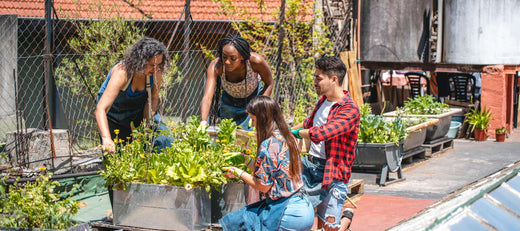Do you want to grow a big garden full of fruits, vegetables, and herbs, but don’t really have the space to grow? You’re not the only one. A community garden is a fantastic solution that provides a shared space for people like you who want to grow but don't have the resources to do it on their own.
What Is A Community Garden?

Community gardens are simply shared green spaces for people to grow plants. There’s no one set model for a community garden: it might be a cooperative space run by a non-profit organization, an educational space sponsored by a school or university, a designated area for the neighborhood to grow food or flowers, or an outreach program to feed people who don’t have access to fresh fruits and vegetables.
Are Community Gardens Free?
Not always. Some community gardens are free to use, while others require membership fees or charge for plot rentals. These fees often go to providing the gardens with tools, materials, and maintenance. If cost is an issue, sometimes a sliding fee schedule is available. Because they are often run by volunteers, some gardens have a requirement that anyone who uses the garden must contribute time or materials to use the garden.
How to Find Community Gardens Near Me
Sometimes it can be tricky to find a community garden that you can participate in. Here are a few resources to help you with your search.
Search online. This might take a little bit of digging. If a simple web search for “community gardens near me” or your zip code doesn’t work, look for more general local meetups and organizations. Websites like the American Community Gardening Association (ACGA) maintain a directory of community gardens across the United States. Visit their website to search for a garden in your area.
Check with your local extension office. These are usually connected to a university. Cooperative extensions provide wonderful resources for gardeners, including soil testing, information about local growing conditions, native plants, and sometimes even workshops and other resources.

Join a gardening club or horticultural society. These groups often have connections to community gardens and can help you find one that fits your needs. You’ll also get to know people who share your interests and can help you succeed.
Visit the local library. Libraries are a great hub of information and community. They often have bulletin boards with information about local gardens and related events. Library staff may also have some knowledge of nearby community gardens.
Check with schools and colleges. Sometimes local gardens are run by local schools, colleges, or universities. Check with your local school board or college to ask about any affiliated gardens or resources they may provide to help you find one.
Start your own. If you’ve explored all these options and there’s nothing suitable in your area, then why not form your own? You’re probably not the only hopeful gardener in your area looking for a green space to share. Band together with like-minded friends and work together to make your dream a reality. You’ll need permission from the locals (including any homeowner’s association), proper zoning, and any necessary permits.
When forming a community garden, decide on general rules and guidelines from the beginning. This will help divide the workload and establish leadership roles for decision-making, fundraising, volunteer coordination, and other responsibilities. Having an organized plan together will encourage more people to participate and will give the community a sense of ownership in the garden.

You’ll need a good location for your community garden. Look for a spot with room to grow, plenty of sunlight, access to water, and good soil quality. You may have to think outside of the box for this step. If your local soil is contaminated or there isn’t much available growing space, consider a raised bed community garden. If there’s no nearby water hookup, water catchment systems may be a big help.
Once you’ve secured a location, soil, and water, you’re well on your way! You’ll also need tools and materials, including seeds! Seeds are ideal for a community garden because they are inexpensive compared to potted plants, and they allow you to have more control over the conditions your plants are grown in, giving you a greater chance of success from the start. Jumpstart your garden with Farmer’s Pack, Homesteader Collection, and Home Garden Collection. You’ll have 180 different varieties of seeds to choose from, including fruits, vegetables, herbs, flowers, and even cover crops.
























